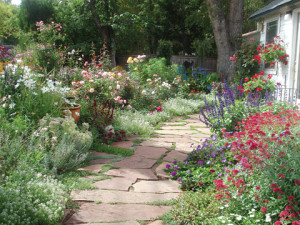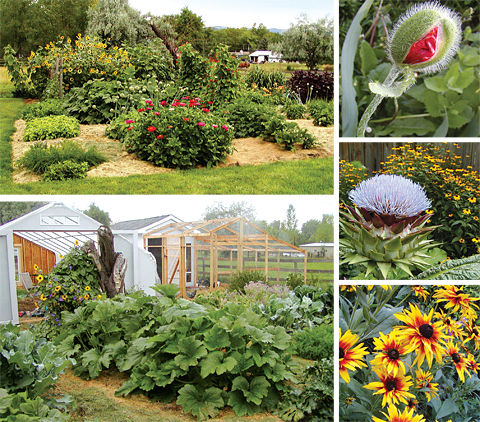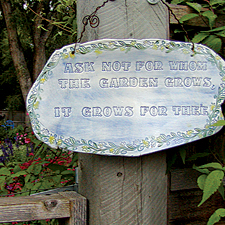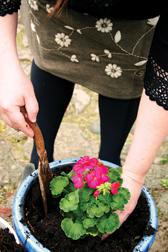The Thrill of No-Till
04 Mar 2010
This organic garden stays healthy because its soil creatures are happy with the homeowners’ till-free techniques.
Barbara Miller caught the gardening itch at an early age. Her childhood chore was tending the family strawberry patch and selling the berries. “I sold quarts on the roadside for a quarter,” recalls the Boulder gardener. “That was a lot of money back then!” Today, Barbara and her husband, Morris, are more apt to give away their garden’s bounty, which includes every kind of vegetable and perennial they can squeeze onto their one-acre property in east Boulder. Alyssum flanks a path in Barbara and Morris Miller’s garden, where cosmos, sedum, geranium, valerian, salvia, and ‘Rozanne’, ‘Jeanne Lajoie’, ‘Queen Elizabeth’ and ‘Zephirine Drouhin’ roses create a meditative backdrop for the potted water feature that houses a dwarf papyrus sedge in summer.
Although seemingly a traditional garden, the couple’s rural plot teems with surprises. Home to cottage-style favorites like red valerian, old roses and hollyhocks, the plot also sports chic, urban containers like the shiny chrome wheel that hosts a Virginia creeper vine. Vegetables and fruits poke from all places. Cantaloupes, basil and artichokes with ocean-blue blossoms grow alongside sweet-scented stargazer lilies. Ruffled peony poppies add bolts of bright fuchsia, and a papyrus-laden water feature provides a meditative splash.
Alyssum flanks a path in Barbara and Morris Miller’s garden, where cosmos, sedum, geranium, valerian, salvia, and ‘Rozanne’, ‘Jeanne Lajoie’, ‘Queen Elizabeth’ and ‘Zephirine Drouhin’ roses create a meditative backdrop for the potted water feature that houses a dwarf papyrus sedge in summer.
Although seemingly a traditional garden, the couple’s rural plot teems with surprises. Home to cottage-style favorites like red valerian, old roses and hollyhocks, the plot also sports chic, urban containers like the shiny chrome wheel that hosts a Virginia creeper vine. Vegetables and fruits poke from all places. Cantaloupes, basil and artichokes with ocean-blue blossoms grow alongside sweet-scented stargazer lilies. Ruffled peony poppies add bolts of bright fuchsia, and a papyrus-laden water feature provides a meditative splash.
 For the Millers, “gardening” is spelled with a capital ‘O’ for organic. From day one, the couple relied on noninvasive techniques to carve their vegetable and perennial beds from the rocky, hard-packed sod they encountered when they moved here from Eugene, Ore., in 1999. They even refused to rototill for fear of destroying soil microorganisms.
Instead, they layered the ground with nearly a foot of biodegradable mulch and piled on more as the bottom layers rotted into nutrients and loam. Within a matter of months, their hard pack gave way to heaps of pristine, earthworm-laden garden soil.
Today, Barbara’s heirloom perennials dazzle like confetti, offering a kaleidoscope of blooms throughout the seasons. Yellow and crimson chard flourish in fertile beds, and dahlias flaunt jewel-tipped blossoms alongside some of the county’s tastiest arugula.
The Millers left behind Eugene’s agreeable climate to spend more time with their grandchildren, who live in Louisville and Boulder. Because they moved during Fourth of July week, Barbara knew it was too late to establish a vegetable garden in Colorado that year. So she brought her Oregon garden with her. The Millers journeyed over the Tetons and Rockies towing a cumbersome U-Haul full of possessions, including hundreds of seedlings. “I rented this huge trailer to take all of our stuff across country,” Morris says, “and Barbara filled it nearly half full with plants!”
By fall, Barbara’s ready-made garden included tried-and-true favorites: hardy roses, artichokes, poppies and brown-eyed Susans. Her prized Mexican primroses quickly spread in a tidy line along the new fence the couple built to corral the front yard. “I love these,” Barbara says. “They are so obedient.” Comfrey starts filled in the length of the pasture’s fence, where the couple’s three Nubian goats, Apollo, Jupiter and Mercury, frolic. The goats also supply the garden with organic compost.
Despite a few casualties, like the fledgling Japanese maple that foundered its first year in Boulder, Barbara is happy with the local climate. “It’s much easier to grow roses here in the dry air,” she says. “In Oregon, you have so many diseases related to humidity.” In fact, a transplant from a 50-year-old rosebush grew so large that Barbara plucked it up and passed it along to a daughter-in-law.
For the Millers, “gardening” is spelled with a capital ‘O’ for organic. From day one, the couple relied on noninvasive techniques to carve their vegetable and perennial beds from the rocky, hard-packed sod they encountered when they moved here from Eugene, Ore., in 1999. They even refused to rototill for fear of destroying soil microorganisms.
Instead, they layered the ground with nearly a foot of biodegradable mulch and piled on more as the bottom layers rotted into nutrients and loam. Within a matter of months, their hard pack gave way to heaps of pristine, earthworm-laden garden soil.
Today, Barbara’s heirloom perennials dazzle like confetti, offering a kaleidoscope of blooms throughout the seasons. Yellow and crimson chard flourish in fertile beds, and dahlias flaunt jewel-tipped blossoms alongside some of the county’s tastiest arugula.
The Millers left behind Eugene’s agreeable climate to spend more time with their grandchildren, who live in Louisville and Boulder. Because they moved during Fourth of July week, Barbara knew it was too late to establish a vegetable garden in Colorado that year. So she brought her Oregon garden with her. The Millers journeyed over the Tetons and Rockies towing a cumbersome U-Haul full of possessions, including hundreds of seedlings. “I rented this huge trailer to take all of our stuff across country,” Morris says, “and Barbara filled it nearly half full with plants!”
By fall, Barbara’s ready-made garden included tried-and-true favorites: hardy roses, artichokes, poppies and brown-eyed Susans. Her prized Mexican primroses quickly spread in a tidy line along the new fence the couple built to corral the front yard. “I love these,” Barbara says. “They are so obedient.” Comfrey starts filled in the length of the pasture’s fence, where the couple’s three Nubian goats, Apollo, Jupiter and Mercury, frolic. The goats also supply the garden with organic compost.
Despite a few casualties, like the fledgling Japanese maple that foundered its first year in Boulder, Barbara is happy with the local climate. “It’s much easier to grow roses here in the dry air,” she says. “In Oregon, you have so many diseases related to humidity.” In fact, a transplant from a 50-year-old rosebush grew so large that Barbara plucked it up and passed it along to a daughter-in-law.
Makin’ It Real with No-Till
Growing up in western Pennsylvania, Barbara learned the benefits of mulching to protect plants from harsh weather. As an adult, she became interested in using mulch to make garden soil through the no-till method. She researched books by Ruth Stout, a free-spirited farm girl born in 1884, whose work became the foundation for the no-till methods used by today’s organic farmers. While in her 70s, Stout, who had previously shocked her Connecticut neighbors by gardening nude, produced several books chronicling her experiences as an aging but die-hard gardener, including How to Have a Green Thumb Without an Aching Back and Gardening Without Work. Her advice has also graced the pages of contemporary magazines like Mother Earth News. The no-till method involves layering compostibles on top of ground you wish to claim as garden. Barbara typically uses leaves, grass clippings and manure, and places a thick layer of hay on top. As the materials decompose, she adds more and tucks kitchen waste like coffee grounds and eggshells between the layers. “Good soil is all about the microorganisms and earthworms that break it down and keep it healthy,” Barbara says. “All I’m trying to do is feed them.” In as little as a year the no-till method can turn nutrient-starved dirt into dark, rich soil, she says. Amid the vegetables and flowers, the Millers’ garden sprouts sayings from Shakespeare, Emerson, Martha Stewart and other luminaries. Inspirational quotes dot pathways, and a plaque at the entry gate reminds visitors to “Ask not for whom the garden grows, it grows for thee”—a twist on poet John Donne’s famous line. Morris’s favorite quip: “Gardening is an irrational act,” he says with a laugh.
But the most apropos saying for this garden might be “No one leaves empty-handed.” Every visitor walks away with fresh salad greens or enough basil for savory pesto. If not organic produce, Barbara proffers a handful of hollyhock seeds or a bouquet of freshly cut dahlias. Sometimes it’s just the opportunity to shoot a photo of their brilliant perennials or gather a bit of sage garden advice.
Whatever form the Millers’ generosity takes, no one leaves without a memento from their charming garden.
Amid the vegetables and flowers, the Millers’ garden sprouts sayings from Shakespeare, Emerson, Martha Stewart and other luminaries. Inspirational quotes dot pathways, and a plaque at the entry gate reminds visitors to “Ask not for whom the garden grows, it grows for thee”—a twist on poet John Donne’s famous line. Morris’s favorite quip: “Gardening is an irrational act,” he says with a laugh.
But the most apropos saying for this garden might be “No one leaves empty-handed.” Every visitor walks away with fresh salad greens or enough basil for savory pesto. If not organic produce, Barbara proffers a handful of hollyhock seeds or a bouquet of freshly cut dahlias. Sometimes it’s just the opportunity to shoot a photo of their brilliant perennials or gather a bit of sage garden advice.
Whatever form the Millers’ generosity takes, no one leaves without a memento from their charming garden. 











